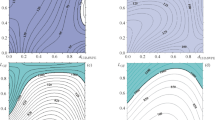Abstract
A general model for the optimal use of materials based on structural optimization is derived. The competitiveness of materials is assessed with merit parameters. The competition between materials (material selection optimization) and the role of the composition and microstructure for a given material (grade optimization) are analyzed. The model is applied to aluminum matrix composites. The influence of matrix material, amount of reinforcement, and value of weight savings is studied. Mechanical properties are analyzed with the aid of published experimental data and available models. The Tsai-Halpin model is used to represent the variation of the elastic modulus with the amount of reinforcement. For yield strength the modified shear lag model is applied. It can satisfactorily describe experimental data and the variation with reinforcement for high-strength matrix alloys. For aluminum alloys of medium and lower strength, the observed increase is larger than the predicted one. This can be explained with the help of more recently developed micromechanical models that take into account the changes in microstructure in the matrix. For structural parts, large values of weight savings are usually necessary to make the particulate-reinforced composites competitive with carbon steel or their parent aluminum alloys. In other applications, combinations of properties are important to make the composites competitive.
Similar content being viewed by others
References
J. Eliasson and R. Sandstrom, “Applications of Al-Matrix Composites,” Royal Institute of Technology, Stockholm, Sweden, 1992
S.A. Gieskes and M. Terpetra, Ed.,Metal Matrix Composites, Elsevier, 1991
B. Terry and G. Jones,Metal Matrix Composites, Elsevier Science Publishers, Ltd., Oxford, England, 1990
S. Suresh, A. Mortensen, and A. Needleman,Fundamentals of Metal Matrix Composites, Butterworth-Heinemann, 1993
B.J.D. Esping, “Structural Optimization Using Numerical Techniques,” Ph.D. thesis, Royal Institute of Technology, Stockholm, Sweden, 1985
S. Hernandez and C.A. Brebbia, Ed.,Optimisation of Structural Systems and Industrial Applications, Elsevier, 1991
K. Imai, Structural Optimisation to Include Material Selection,Int. J. Num. Methods Eng., Vol 19, 1983, p 217–235
R. Sandstrom, An Approach to Systematic Materials Selection,Materials and Design, Vol 6, 1985, p 328–338
R. Sandstrom, Systematic Selection of Materials in Light Weight Design,Fourth Scandinavian Symposium on Materials Science, The Norwegian Institute of Technology, Trondheim, Norway, 1986, p 255–268
R. Sandstrom, New Principles for Systematic Material Selection Using Merit Parameters,Conf. on Modern Design Principles, K. Jakobsen, Ed., The Norwegian Institute of Technology, Trondheim, Norway, 1988, p 55–74
R. Sandstrom, Merit Parameters in Materials Optimisation,Materials and Design, Vol 13, 1992, p 131–137
R. Sandström, Control Area Diagrams in Materials Optimisation,Materials and Design, Vol 13, 1992, p 195–202
M.F. Ashby,Material Selection in Mechanical Design, Pergamon, 1992, p 56–69
D. Hull,An Introduction to Composite Materials, R.W. Cahn, E.A. Davis, and I.M. Ward, Ed., Cambridge University Press, Cambridge, England, 1981
W.C. Harrigan, Jr., Discontinuous Silicon Fiber MMCs,Composites, Vol 1, Engineered Materials Handbook, T.J. Reinhart et al., Ed., ASM International, 1987, p 889–895
J.F. Dolowy Jr., Increasing Focus on Silicon Carbide Reinforced Aluminium Composites,Light Metal Age, Vol 44, June 1986, p 7–14
V.C. Nardone and K.M. Prewo, On the Strength of Discontinuous Silicon Carbide Reinforced Aluminium Composites,Scr. Met. Mater., Vol 20, 1986, p 43–48
Material catalog, Duralcan, 1991
T. Christman and S. Suresh, Microstructural Development in Aluminium Alloy SiC-Whisker Composite, Acta Met., Vol 36 (No. 7), 1988, p 1691–1704
I. Dutta and D.L. Bourell, Influence of Dislocation Density and Distribution on the Ageing Behaviour of 6061-Al-SiC Whisker Composites,Acta Met., Vol 38 (No. 11), 1990, p 2041–2049
J.D. Embury and D.J. Lloyd, Strengthening Mechanisms in Aluminum Alloys,Aluminium Alloys—ContemporaryResearch and Applications, A.K. Vasudevan and R.D. Doherty, Ed., Academic Press, p 579–601
Y. Wu and E.J. Lavernia, Strengthening Behaviour of Particulate Reinforced MMC’s,Scr. Met. Mater., Vol 27, 1992, p 173–178
V.C. Nardone, Assessment of Models Used to Predict the Strength of Discontinuous Silicon Carbide Reinforced Aluminium Alloys,Scr. Met. Mater., Vol 21, 1987, p 1313–1318
F.J. Humphreys, A. Basu, and M.R. Djazeb, The Microstructure and Strength of Particulate Metal Matrix Composites,12th Risφ International Symposium on Materials Science, Risφ National Laboratory, Roskilde, Denmark, 1991, p 51–66
D.J. Lloyd, Aluminium Metal Matrix Composites, First International Summer School on Aluminium Alloy Technology, Trondheim, Norway, 1991, available from Alcan International, Ltd., Kingston Research and Development Centre, Box 8400, 945 Princess Street, Kingston, Ontario K7L 5L9, Canada
W.S. Miller and F.J. Humphreys, Strengthening Mechanisms in Paniculate Metal Matrix Composites,Scr. Met. Mater., Vol 25, 1991, p 33–38
Author information
Authors and Affiliations
Rights and permissions
About this article
Cite this article
Eliasson, J., Sandström, R. Material selection and grade optimization applied to aluminum matrix composites. JMEP 4, 358–367 (1995). https://doi.org/10.1007/BF02649073
Published:
Issue Date:
DOI: https://doi.org/10.1007/BF02649073




